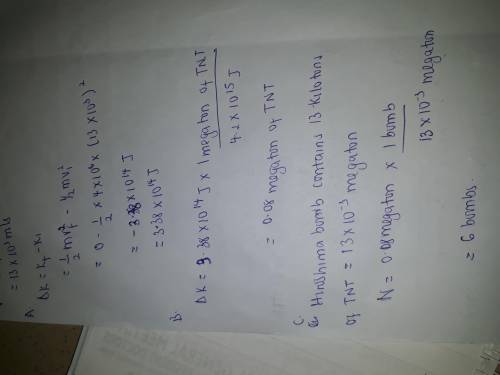
On August 10, 1972, a large meteorite skipped across the atmosphere above the western United States and western Canada, much like a stone skipped across water. The accompanying fireball was so bright that it could be seen in the daytime sky and was brighter than the usual meteorite trail. The meteorite's mass was about 4.0 × 106 kg; it's speed was about 13 km/s. Had it entered the atmosphere vertically, it would have hit Earth's surface with about the same speed. (a) Calculate the meteorite's loss of energy (as a positive number, in joules) that would have been associated with the vertical impact. (b) Express the energy as a multiple of the explosive energy of 1 megaton of TNT, which is 4.2 × 1015 J. (c) The energy associated with the atomic bomb explosion over Hiroshima was equivalent to 13 kilotons of TNT. To how many Hiroshima bombs would the meteorite impact have been equivalent?

Answers: 3


Another question on Physics

Physics, 21.06.2019 21:20
An artificial satellite circles the earth in a circular orbit at a location where the acceleration due to gravity is 6.03 m/s^2. determine the orbital period of the satellite.
Answers: 3

Physics, 22.06.2019 04:10
You will be galileo perform the experiment to determine if objects with different mass fall at the same, or different, rates in the air and in a vacuum. (refer to the walk-through video to locate the online lab within the online textbook).
Answers: 2

Physics, 22.06.2019 08:00
While studying chemical reactions and conservation of matter, sarah's class conducted a variety of experiments. sarah and her lab partner found the mass of a wax candle and placed the candle in a flask. the students lit the candle and let it burn to completion. all that was left was wax and charred candle wick. per their teacher's instructions, the students found the mass of the products. their data can be seen in the data table. formulate a hypothesis the students could test to explain why the experiment did not support the law of conservation of matter. a) the students could repeat the experiment using different candles; there might have been a flaw in the candle. b) the experiment should be repeatable. the students should run several trials and then take an average of the after mass in each trial. c) the students should have someone in the class check their measurement skills as they repeat the experiment. they may have made an error using the balance. d) the students should burn the candle in a container that has some type of lid so that any gas that is a product of the reaction can be contained and massed. submit
Answers: 2

Physics, 22.06.2019 16:00
Agroup of monkeys is trying to cross the river in a rowboat. the maximum buoyant force on the rowboat is 2,000 n. the weight of the rowboat is 1,000 n. each monkey has a weight of 150 n. how many monkeys can safely cross in the rowboat at one time? explain your reasoning, including any calculations you used to find the answer.
Answers: 1
You know the right answer?
On August 10, 1972, a large meteorite skipped across the atmosphere above the western United States...
Questions


Mathematics, 30.06.2019 15:00

Biology, 30.06.2019 15:00



Biology, 30.06.2019 15:00

Mathematics, 30.06.2019 15:00



Mathematics, 30.06.2019 15:00

History, 30.06.2019 15:00


Biology, 30.06.2019 15:00


History, 30.06.2019 15:00


Mathematics, 30.06.2019 15:00

Mathematics, 30.06.2019 15:00






